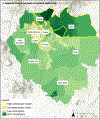The association between urban greenspace and psychological health among young adults in Addis Ababa, Ethiopia
- PMID: 36084675
- PMCID: PMC10038305
- DOI: 10.1016/j.envres.2022.114258
The association between urban greenspace and psychological health among young adults in Addis Ababa, Ethiopia
Abstract
Introduction: Psychological disorders are emerging as health priorities in Sub-Saharan Africa, specifically Ethiopia. Urban greenspace - parks, trees, and other vegetation integrated into urban form - may facilitate population psychological health, but is largely understudied outside high-income countries. We explore greenspace in relation to psychological health among young adults in Addis Ababa, Ethiopia.
Method: Greenspace exposure was calculated using the normalized difference vegetation index (NDVI) derived from publicly available satellite imagery (2018-2019). We used tests of spatial clustering to characterize greenspace distribution. Derived NDVI values were linked to Positive Outcomes for Orphans study participants to explore cross-sectional associations between greenspace exposure and psychological health (measured 2019-2021). Two continuous scores of psychological health were examined: total difficulties from the Strengths and Difficulties Questionnaire and depressive symptoms from the 8-item Patient Health Questionnaire. Multilevel generalized linear regression, nested by administrative units, was used to estimate the association between greenspace and psychological health. We also explored effect modification by gender and having income.
Results: We found greenspace is spatially clustered in Addis Ababa, with high greenspace density in the northeast region and low greenspace density in the center of the city. Our findings suggest residing in greener areas is associated with fewer emotional and behavioral difficulties (β = -1.89; 95% CI: -3.50, -0.29), but not significantly associated with depressive symptomology (β = -0.61; 95% CI: -2.33, 1.11). We observed stronger associations between greenspace and total difficulties among those reporting any income and among males, and for the association between greenspace and depression symptomology among males.
Conclusion: We offer initial exploration into the role of greenspace in psychological well-being in Addis Ababa, with potential implications for urban communities across Sub-Saharan Africa. Further research should continue to explore how the built and natural environment could be leveraged in similar settings to promote population psychological health.
Copyright © 2022 Elsevier Inc. All rights reserved.
Conflict of interest statement
Declaration of competing interest The authors declare that they have no known competing financial interests or personal relationships that could have appeared to influence the work reported in this paper.
Figures
References
-
- Akpinar A, 2016. Factors Influencing the Use of Urban Greenways: A Case Study of Aydin, Turkey, vol. 16. Urban For Urban Green, pp. 123–131.
-
- Ambrey CL, 2016. Urban greens pace, physical activity and wellbeing: the moderating role of perceptions of neighbourhood affability and incivility. Land Use Pol. 57, 638–644. 10.1016/j.landusepol.2016.06.034. - DOI
-
- Arsiso BK, Mengistu Tsidu G, Stoffberg GH, Tadesse T, 2018. Influence of urbanization-driven land use/cover change on climate: the case of Addis Ababa, Ethiopia. Phys. Chem. Earth, Parts A/B/C 105, 212–223. 10.1016/j.pce.2018.02.009. - DOI
Publication types
MeSH terms
Grants and funding
LinkOut - more resources
Full Text Sources
Medical




